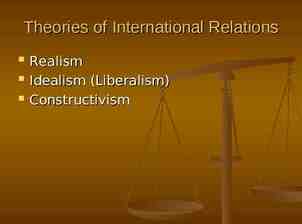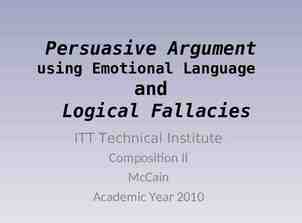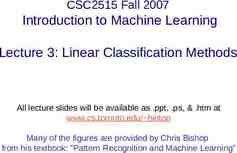Electromagnetism Electromagnetism is one of the fundamental forces
26 Slides179.50 KB

Electromagnetism Electromagnetism is one of the fundamental forces in nature, and the the dominant force in a vast range of natural and technological phenomena The electromagnetic force is solely responsible for the structure of matter, organic, or inorganic Physics, chemistry, biology, materials science The operation of most technological devices is based on electromagnetic forces. From lights, motors, and batteries, to communication and broadcasting systems, as well as microelectronic devices. Engineering

Electromagnetism Electricity Magnetism Optics Electromagnetism In this course we are going to discuss the fundamental concepts of electromagnetism: charge force field potential current electric circuit magnetic field induction alternating currents waves reflection refraction image interference diffraction Once you master these basic concepts, you will be ready to move forward, into more advanced subjects in your specific field of interest

System of Units We will use the SI system – SI International System of Units Fundamental Quantities Length meter [m] Mass kilogram [kg] Time second [s] Other Units Current ampere [A] Derived Quantities Force newton Energy joule Charge coulomb Electric Potential volt Resistance ohm 1 N 1 kg m / s2 1J 1Nm 1C 1As 1V 1J/C 1 1V/A

Electrostatics Chapter 23

Electric Charge The Transfer of Charge SILK Glass Rod Some materials attract electrons more than others.

Electric Charge The Transfer of Charge - SILK Glass Rod As the glass rod is rubbed against silk, electrons are pulled off the glass onto the silk.

Electric Charge The Transfer of Charge - SILK Glass Rod Usually matter is charge neutral, because the number of electrons and protons are equal. But here the silk has an excess of electrons and the rod a deficit.

Electric Charge The Transfer of Charge - SILK Glass Rod Glass and silk are insulators: charges stuck on them stay put.

Electric Charge Two positively charged rods repel each other.

Electric Charge History 600 BC Greeks first discover attractive properties of amber when rubbed. 1600 AD Electric bodies repel as well as attract 1735 AD du Fay: Two distinct types of electricity 1750 AD Franklin: Positive and Negative Charge 1770 AD Coulomb: “Inverse Square Law” 1890 AD J.J. Thompson: Quantization of electric charge - “Electron”

Electric Charge Summary of things we know: – There is a property of matter called electric charge. (In the SI system its units are Coulombs.) – Charges can be negative (like electrons) or positive (like protons). – In matter, the positive charges are stuck in place in the nuclei. Matter is negatively charged when extra electrons are added, and positively charged when electrons are removed. – Like charges repel, unlike charges attract. – Charges travel in conductors, not in insulators – Force of attraction or repulsion 1 / r2

Charge is Quantized q multiple of an elementary charge e: e 1.6 x 10-19 Coulombs electron proton neutron Charge -e e 0 Mass 1 1836 1839 Diameter 0 10-15m 10-15m positron e 1 0 (Protons and neutrons are made up of quarks, whose charge is quantized in multiples of e/3. Quarks can’t be isolated.)

Coulomb’s Law q1 q2 r12 F12 r12 kq1 q2 ˆ F 12 2 r12 r12 Force on 2 due to 1 k (4 0)-1 9.0 x 109 Nm2/C2 permitivity of free space 8.86 x 10-12 C2/Nm2 Coulomb’s law describes the interaction between bodies due to their charges

Gravitational and Electric Forces in the Hydrogen Atom M e r12 -e m Gravitational force m 9.1 10-31 kg M 1.7 10-27 kg r12 5.3 10-11 m Electric Force

Gravitational and Electric Forces in the Hydrogen Atom M e r12 -e m Gravitational force Mm Fg G 2 r r12 Fg 3.6 10-47 N m 9.1 10-31 kg M 1.7 10-27 kg r12 5.3 10-11 m Electric Force

Gravitational and Electric Forces in the Hydrogen Atom M e r12 -e m Gravitational force Mm Fg G 2 r r12 Fg 3.6 10-47 N m 9.1 10-31 kg M 1.7 10-27 kg r12 5.3 10-11 m Electric Force 1 Qq Fe 2 r 4 0 r12 Fe 3.6 10-8N

Superposition of forces from two charges Blue charges fixed , negative, equal charge (-q) What is force on positive red charge q ? y x

Superposition of forces from two charges Blue charges fixed , negative, equal charge (-q) What is force on positive red charge q ? Consider effect of each charge separately: y x

Superposition of forces from two charges Blue charges fixed , negative, equal charge (-q) What is force on positive red charge q ? Take each charge in turn: y x

Superposition of forces from two charges Blue charges fixed , negative, equal charge (-q) What is force on positive red charge q ? Create vector sum: y x

Superposition of forces from two charges Blue charges fixed , negative, equal charge (-q) What is force on positive red charge q ? Find resultant: y NET FORCE x

Superposition Principle F31 q1 q2 q3 F31 F F31y F21 F31x Forces add vectorially F (F21x F31x) x (F21y F31y) y F21y F21 F21x

Example: electricity balancing gravity Two identical balls, with mass m and charge q, hang from similar strings of length l. After equilibrium is reached, find the charge q as a function of and l l q m q m

Example: electricity balancing gravity What forces are acting on the charged balls ? q m l q m

Example: electricity balancing gravity Draw vector force diagram while identifying the forces. Apply Newton’s 3rd Law, for a system in equilibrium, to the components of the forces. Solve! T T FE FE FG mg FG mg







